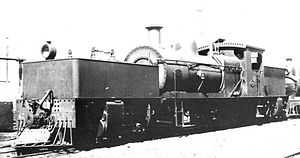WAGR G class
| WAGR G class | |
|---|---|
|
G 233 Leschenault Lady, at Bassendean, 2006. | |
| Type and origin | |
| Power type | Steam |
| Specifications | |
| Configuration | 2-6-0 and 4-6-0 |
| Gauge | 3 ft 6 in (1,067 mm) |
| Career | |
| Operator(s) | Western Australian Government Railways |
The WAGR G class was a class of steam locomotives designed by Beyer, Peacock & Co and used by the Western Australian Government Railways (WAGR) from 1889. The class's wheel arrangement varied; some were 2-6-0 and the rest were 4-6-0.[1]
A total of 48 G class engines were acquired by the WAGR between 1889 and 1899, and they were the first class of locomotives to be introduced to the WAGR network in quantity. They were also part of what became almost an Australian 3 ft 6 in (1,067 mm) standard, as locomotives of similar design served in large numbers in South Australia (as the SAR Y class) and Tasmania (as the TGR C class), and also in Queensland, on the North Australia Railway, and on several private railways.[1]
The class remained in service in significant numbers until the 1960s. Several have been preserved, including G 233 Leschenault Lady and G 123 Koombana Queen, both of which remained on the WAGR's books well into the diesel era.[2]
See also
- History of rail transport in Western Australia
- List of Western Australian locomotive classes
- MRWA G class – a class of diesel-electric locomotives also designated as the WAGR G class
References
Notes
- ↑ 1.0 1.1 Gunzburg 1984, p. 29.
- ↑ Gunzburg 1984, pp. 30-34.
Cited works
- Gunzburg, Adrian (1984). A History of WAGR Steam Locomotives. Perth: Australian Railway Historical Society (Western Australian Division). ISBN 0959969039.
External links
![]() Media related to WAGR G class at Wikimedia Commons
Media related to WAGR G class at Wikimedia Commons
| |||||||||||||||||||||||||||||||||||||
.jpg)

